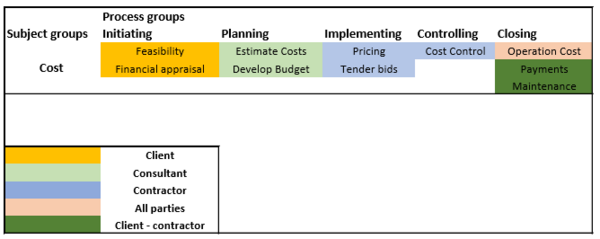Construction Cost Management
Construction Cost Management
Contents |
Introduction
Cost Management in construction industry and the measurement of the financial activities involved there are unique and completely different from financial management of other industries. The basic production unit of the construction industry is the project. Thus, in contrast to the other industries, the number of projects in construction, is relatively small compared to other industries. Considering also the expended time frame and the multiple stakeholders, which are involved in this one project, the differences in the cost management from other industries can be realized.
Construction Cost Management is presented as a subject group as in DS/ISO 21500:2013. It is analyzed in the processes groups, illustrating by the aforementioned standard. The definition of the process group according to the DS/ISO 21500:2013 is the following:
- Initiating
- Planning
- Implementing
- Controlling
- Closing
Initiating
Development of the project
Feasibility
Planning
Cost Estimation
Basic approaches on cost estimation
Unit Cost Method of Estimation
Methods for Allocation of Joint Costs
Historical Cost Data
Application
Th use of historical data for cost estimation is a common procedure in the construction industry. Historical data is useful when it is collected and properly structured for for future applications. Consulant engineering and construction companies continuously keep record of their construction cost estimating economic activities. The available data is structured according to the needs of the specific organization.
Limitations and Challenges
- Changes in relative prices result on serious changes in construction costs
- Prediction over long period of time is quite difficult
- Possibility of errors in analysis, due to uncertainties
Cost Indices
Quantity take-off
Computer Aided Cost Estimation
Cost Estimation of construction projects in the preliminary design stage is a rather challenging task, due to the lack of available project information. Therefore, cost estimation models using parametric computational methods have been developed. Such cost estimating model techniques in the preliminary design phase are [1]:
- Multi regression models
- Neural network models
- Case-based reasoning models
Implementing
Pricing is determined by a large number of factors. The bid, which is submitted by a contractor, depends on
- cost estimation
- contractor's profit
Tendering
Contracting [2]
Construction contracts is the mean for pricing a construction project and stands out as an official agreement between the client, the contractor and the possible other stakeholders, who are involved in the contract. Contracts are a structure for the allocation of risks between the involved parties in the project. The type of contract, which will be used for the construction of a project, is decided solely by the client, who also sets the term on the contractual agreement. Different type of contracts pose also different risks for the contractor. Some types of contractual agreement, which are used in construction industry, are listed below:
- Lump Sum Contract
- Unit Price Contract
- Cost Plus Fixed Percentage Contract
- Cost Plus Fixed Fee Contract
- Cost Plus Variable Percentage Contract
- Target Estimate Contract
- Guaranteed Maximum Cost COntract
Controlling
The primary objective of Construction Cost Control is the delivery of the project within the approved budget.
Project Cash Flow
Cost Control
Closing
Operation Costs
Payments
Maintenance Cost
Notable Mentions
Technology trends in Construction Cost Management
5D Estimating Building Information Systems
Software, many, platforms, getting the data for estimation to the interest parties, inhouse software for pricing in companies, due to fierce competition
Integrated Project Delivery and Target Value Design
3D Scanning
Offsite Manufacturing
Lean Constuction
References
- ↑ Kim G. H. et al. (2004) Comparison of construction cost estimating models based on regression analysis, neural networks, and case-based reasoning, Building and Environment, Vol. 39, Issue 10, pp.1235-1242, Elsevier https://doi.org/10.1016/j.buildenv.2004.02.013
- ↑ Hendrickson C., Au T., (2008) Project Management for Construction: Fundamental Concepts for Owners, Engineers, Architects and Builders, Version 2.2, [URL:http://http://pmbook.ce.cmu.edu/] Retrieved on 13 December 2017
Annotated bibliography
- 1. Winch, G. M. (2010), "Managing Construction projects". Second edition
- Summary: The book presents a holistic approach of construction management. The basic principles of construction project management are presented along with different tools and techniques that aims to enhance construction performance and provide innovative techniques. The use of information and communication technologies is also a point of interest in the book.
- 2. Kerzner, H., Ph.D., (2006), "Project Management: A systems approach to planning, scheduling and controlling". Ninth edition
- Summary: The book illustrates the basic principles of project management. The book is targeting for enhancing the project skills of not only students, but also executives, pointing out that project management can be related to every profession apart from engineeering, including information systems and business.
- 3. Maylor, H. (2010), "Project Management". Fourth Edition
- Summary: This book cover all the topics of project management, focusing in the theory, as well as in the application and usage of the ideas discussed in it. The book points great emphasis into the 4D-model of the project.
- 4. Flyvbjerg, B. (2008) "Curbing Optimism Bias and Strategic Misrepresentation in Planning": Reference Class Forecasting in Practice, European Planning Studies Vol. 16, No. 1
- Summary: This paper presents the method and illustrates the first instance of reference class forecasting. The paper targets in the inaccuracy of the financial appraisal in planning in construction, explains them in terms of optimism bias and strategic representation and present a method of eliminating this inaccuracy.
